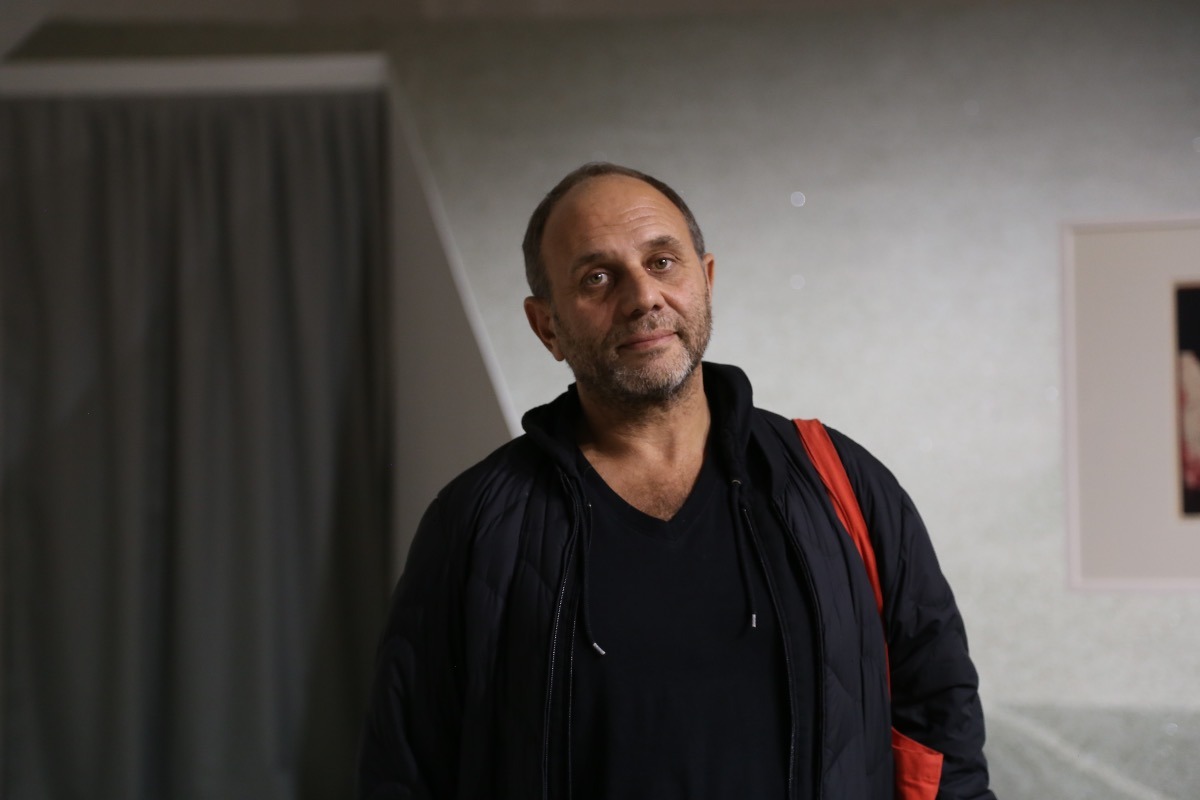
The endless potential of immortality
A conversation with Anton Vidokle, a Moscow-born American artist, the founder of e-flux online platform
One thing that you can certainly say about Anton Vidokle is that he is a cosmopolitan person. And not only because Anton spent his childhood years in Moscow, followed by a move to New York. Now he divides his time between the Big Apple and Berlin, but exhibitions and his countless projects frequently take him to a huge variety of geographical locations. We met on the cusp of 2020 in Riga, where he took part in the Unexpected Encounters exhibition, dedicated to echoes and refractions of ideas of the future that existed in the 20th century. Vidokle was going to return to Riga in May 2020 to start working with the Institute of the Cosmos on a project for the Riga International Biennial of Contemporary Art. Right now all the plans are changing and we are experiencing probably the biggest challenge for all our societies, but many people agree that it’s an opportune time to posit deeper and more ethically responsible understandings of our lives and our futures.
We thought it significant that the majority of Vidokle’s recent works deal with the subject of so-called Russian cosmism ‒ a set of ideas born among a circle of people including the philosopher Nikolai Fedorov, who believed that the human race exists with the single objective of resurrecting all the generations of its ancestors and populating the universe with them. In the context of this system of ideas, humans are viewed not as passive but rather active and creative beings guided by the ideology of unity between humanity and the cosmos and the goal of uniting all the inhabitants of Earth, present and past.
And yet Vidokle’s artistic trajectory also intersects some completely different areas. In 1998 he founded the e-flux online platform, without which the art scene of the past twenty years cannot be imagined. Later, he and his colleague Julieta Aranda co-founded the much-discussed and debated Time/Bank, an attempt to introduce an alternative economic model into the artistic environment. We began our conversation with earlier “layers” of Vidokle’s past. Several cups of coffee at various Riga cafés and changing views outside the window accompanied us on this temporal conversation/journey, which now seems so long ago though it happened just a few months before. This April Anton updated this text just before the publication.
Anton Vidokle, still from Immortality For All: a film trilogy on Russian Cosmism (2014-2017). HD video, color, sound. 96 minutes. Russian with English subtitles. Courtesy of the artist
After your family moved to the United States, did you live in New York?
I’ve lived in New York the larger part of my life. About fifteen years ago I started spending a lot of time in Berlin and started thinking that perhaps I would not return to America. But my parents live here and e-flux is here, and so at a certain point I started spending more and more time in New York again and before I knew it, I was basically back... These days we are staying at a kind of a secluded house in a forest upstate, in self-isolation. It’s a strange experience for me, because I always lived in big cities: Moscow, New York, Berlin, Beirut, etc. I don’t even know how to drive. But I am starting to get used to life in a forest. Maybe it doesn’t matter so much where one physically lives? As long as there is the internet…
What was the New York scene like in the late 1980s and early 1990s?
It was very interesting. Counterculture was still alive back then. There were art venues and spaces that simply could not survive today, like all sorts of experimental music and performance clubs, unusual exhibition spaces, etc. Everything has become much more expensive and commercial today and it’s very difficult to start something like that in New York now. At that time, the more experimental cultural scene was very active, located mainly downtown: in the East Village and Soho. Accidentally we ended up living not far from there, so I was very lucky to have witnessed some of that. Now I’m sorry that I wasn’t involved in that scene more actively.
Were you already an artist in those times?
I was doing all sorts of things back then: going to art school, doing window displays for shops, working as an art installer in museums and galleries, etc. After the Wall Street crash in the late 80s, when all the art-related freelance work dried up, I even worked at a laboratory where they studied diamonds; I was something like a junior researcher (laughs). That was a real nightmare, like working in a submarine or something: it was totally dark all day long, and you sat there with your microscope in front of you. The pay was close to minimum wage, yet you were handling precious stones worth many millions of dollars. Entering and leaving work was like going in and out of a prison: they checked everything because the presumption was that you would try to steal diamonds.
But it was in the second half of the 1990s that things became clearer for me. There was a kind of a change in my mindset. Exhausted by all the economic precarity, I enrolled in a computer programming course. This was at a generic office building on 34th Street in Manhattan. One entire floor of this building was occupied by countless one-room offices, offering various services and classes: from yoga and astrology to programming and foreign languages. You could also see a divorce lawyer, consult a nutritionist, do you taxes, apply for a work visa, etc. In the lobby they had a huge bulletin board with leaflets advertising all these possibilities. It was everything you could ever think of doing to transform or improve yourself, like learning to dance or to speak French. When I saw this object, this bulletin board, I was completely overwhelmed by it. Karl Marx once wrote that to understand human psychology it’s sufficient to take a look at the objects we produce, because they already express all of human desires and fears. And these objects can be deciphered. It was like that for me with this bulletin board: in a sense it was a totally sublime thing that expressed endless possibilities of self-transformation and, at the same time, the total banality of such choices.
Afterwards, I came back to my studio and made a replica of this board. This opened a new artistic direction for me, one that eventually led me to e-flux, to the films that I make and generally to my artistic activities of the past fifteen to twenty years.
Screenshot from the e-flux homepage on February 14, 2020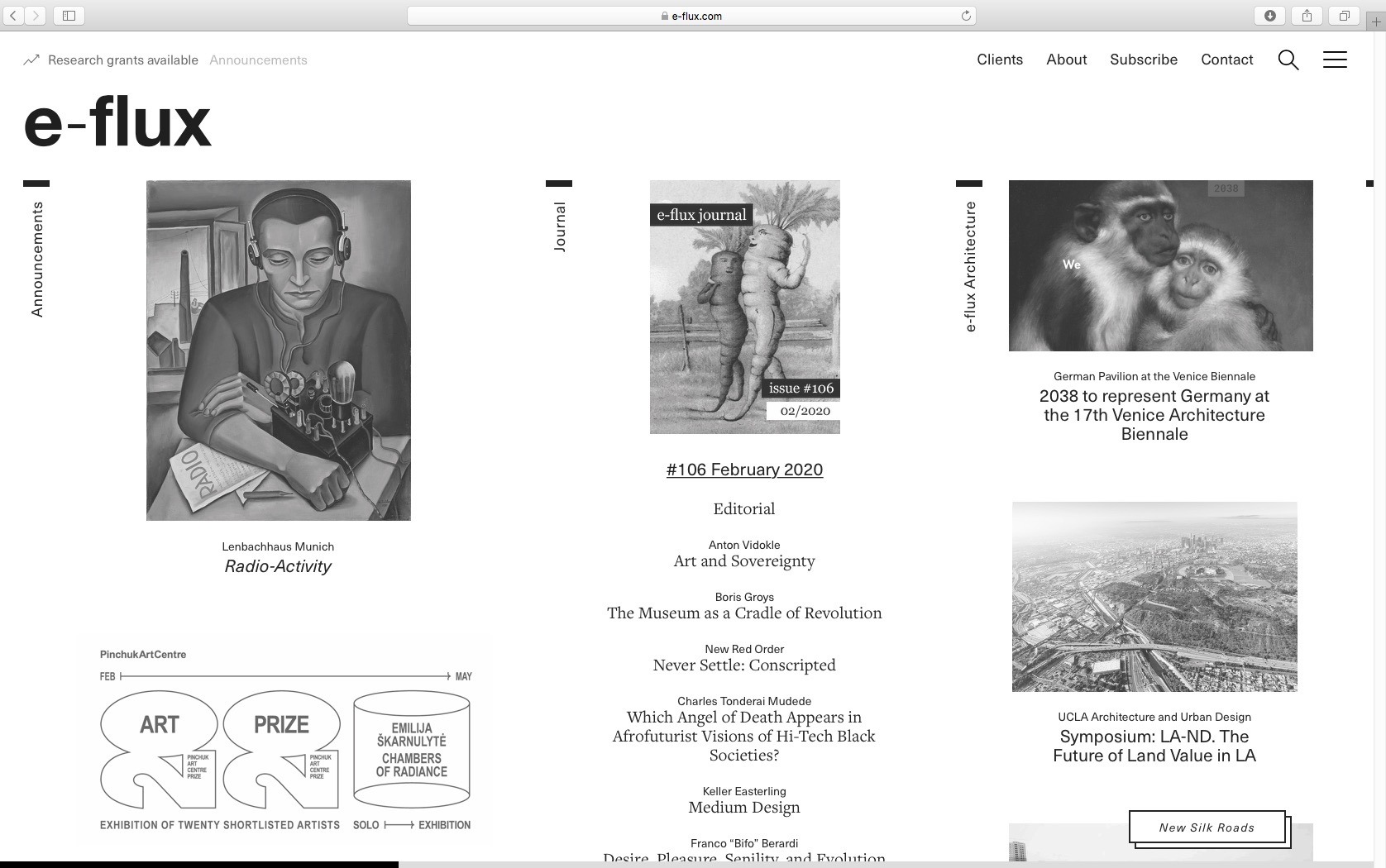
Interestingly, e-flux is also a kind of notice board…
Yes, except it’s electronic and is online.
e-flux was a bit of an accident: around 1998, together with a couple of friends we organized a one-night exhibition called The Best Surprise Is No Surprise. It took place in a room at the Holiday Inn hotel in Chinatown. The show ran from 11 pm to 10 am next morning, because we could afford the room for only one night. We didn’t have any money for printing invitations, mailing press releases and so on. At the time I had just opened an e-mail account with hotmail, and I thought we could try to send out a notice electronically. Not many people had e-mail at the time yet. So we managed to invite only some thirty people this way. But in the end, several hundred people came to see the exhibition.
This constant stream of visitors kept coming to our room throughout the night, and we started to worry that the hotel might ask us to leave the premises. And so we told them a lie ‒ we said we were auditioning for a film, that a very important film director came from Japan for just one night, and there was a casting going on. And that’s why we were expecting a crowd of people, all of them dressed in black (laughs). In New York, cinema is such an influential cultural area that, if you tell people that you’re making a movie, often they’ll let you do whatever you want. So we got away with this, except that in the morning the guys who worked at the hotel also decided that they wanted…
To audition!
Exactly. The exhibition itself was, of course, very unusual. But in a sense, even more surprising was the fact that we sent only a few invites and unexpectedly so many people arrived. I guess it was something like viral dissemination. And it occurred to me that it would be productive to create a platform that could be used by independent curators and small galleries – in other words, anybody lacking a budget for advertising their projects through magazines and the press. And then it sort of happened all by itself. I have no business experience. We simply started sending out invites, and people started subscribing to the mailing list. In a very short time we already had 20,000 or more subscribers. It was then that I realized that they were interested not just in the exhibition press releases but also in e-flux itself.
e-flux journal cover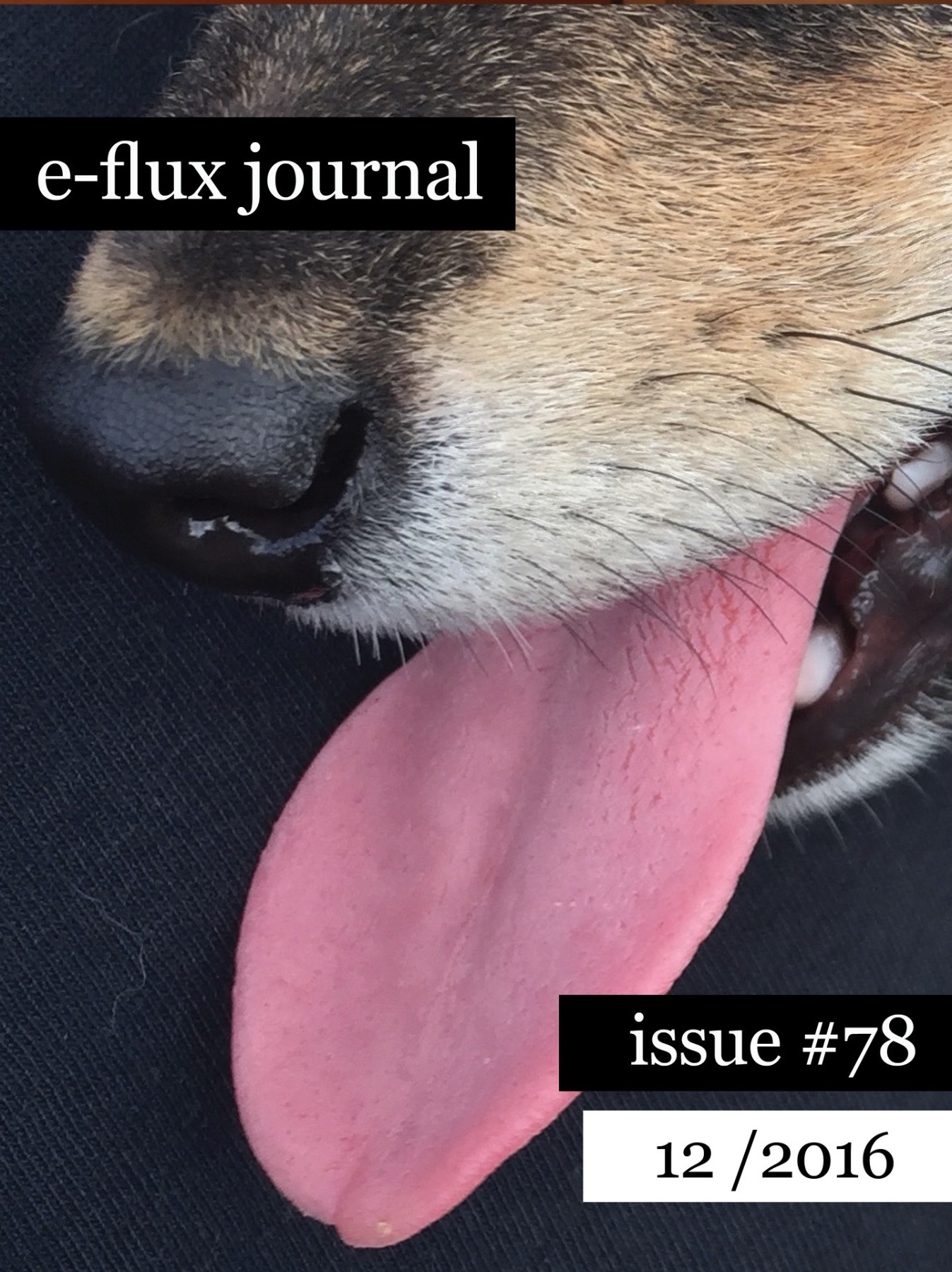
Could we say that the next major project for you was Time/Bank?
There was a whole series of projects before that: e-flux video rental, Martha Rosler Library, unitednationsplaza and others. Just before Time/Bank there was a project we did called Pawnshop. We noticed that for some reason there were quite a lot of pawnshops opening all over New York in 2007. Of course, it was actually hardly a coincidence, because 2008 saw the beginning of the global financial crisis and in 2007 there was already the beginning of this, although there were no spectacular bankruptcies yet. e-flux was based in a very tiny ground floor space on the Lower East Side, which was essentially a space for a shop, so Julieta Aranda and I came up with this Pawnshop project and invited more than 100 artists to pawn various small artworks. Many of our neighbors and people who lived on this street didn’t quite understand that this was actually an exhibition or an art project. For instance, police detectives came to see us because a flat had been burglarized nearby, and the first thing cops do in cases like that is visit the local pawnshops to look for stolen belongings. Our pawnshop actually had all sorts of guitars, cameras, rings and other objects that looked like what you would normally see in a pawnshop, but they were art objects. Trying to explain to a detective that a guitar is not a guitar but a sculpture, that a ring is not a ring but a conceptual art object, and so forth – this was quite an interesting experience because it’s a completely different type of conversation about art than what you would normally have in a gallery or a museum.
At the same time, this model of an art pawnshop really started to function as a business: we were getting lots of calls from secondary market dealers, collectors, etc. – all looking for bargains on art. This really spooked us: the combination of poverty of most artists’ lives and market speculation could work as a successful business plan… When we realized what was happening, we decided to close the shop immediately, and announced that we had gone bankrupt.. Whatever money we earned with this project was eventually donated to Doctors without Borders, for relief for the victims of the earthquake in Haiti.
After the Pawnshop, having had this practical experience with the personal economy of artists, we were curious to continue exploring economy in art in a way that could be more positive. The global financial crisis was at its peak at the time, and Julieta read somewhere about time banking. Time banking is a late 19th-century concept, developed by the American anarchist Josiah Warren, who came up with the idea of a moneyless economy in which you can use the time as currency. To test this theory, Warren opened a shop: The Cincinnati Time Store, where you could buy commodities by paying for them with your time ‒ that is, with your work. His ideas were based on the labor theory of value and various mutual aid societies.
We found this concept very interesting, because there’s a lot of time in the art community, and there’s a lot of knowledge and opportunities for doing things, but there aren’t always sufficient funds and structures that can make them happen. So we decided to set up an online time bank where people could offer their time to help others and also receive help.
Time Bank at dOCUMENTA (13) in 2012. Photo: mydoc13.wordpress.com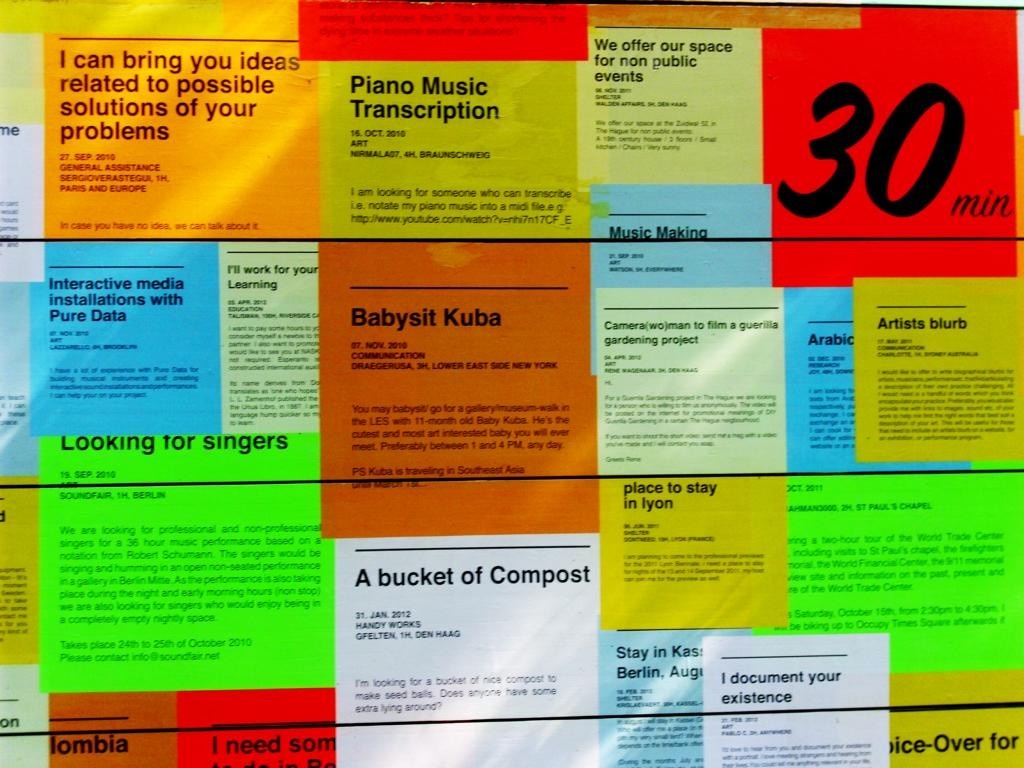
How long did it exist?
More than four years. Eventually we simply became too exhausted to continue to administer the bank. We had fifteen or sixteen physical branches in various cities, usually connected to exhibitions. We issued our own currency called Hour Notes, and opened a number of Time/Stores and canteens called Time/Food. One of the largest branches was at dOCUMENTA 13. Working on that show was really hard, and afterwards we felt burnt out. However one of the bank’s branches still exists at the Hague in Holland. They split away from the main bank because they didn’t want to be a part of a larger art project, but wanted to develop this as a local community initiative.
You mean they left the area of art, abandoned it?
Yes, more or less. I think a lot of people who joined the Hague branch were not from the art field and were not invested or interested in the kind of an international artistic network we were trying to build. For us this project was very much about a kind of a vast mutual aid platform for artists all over the world.
To an extent, the Time/Bank could be described as a utopian project…
Yes, of course.
View from the exhibition “Unexpected Encounters.” Photo: Margarita Ogoļceva, The Latvian Centre for Contemporary Art, 2019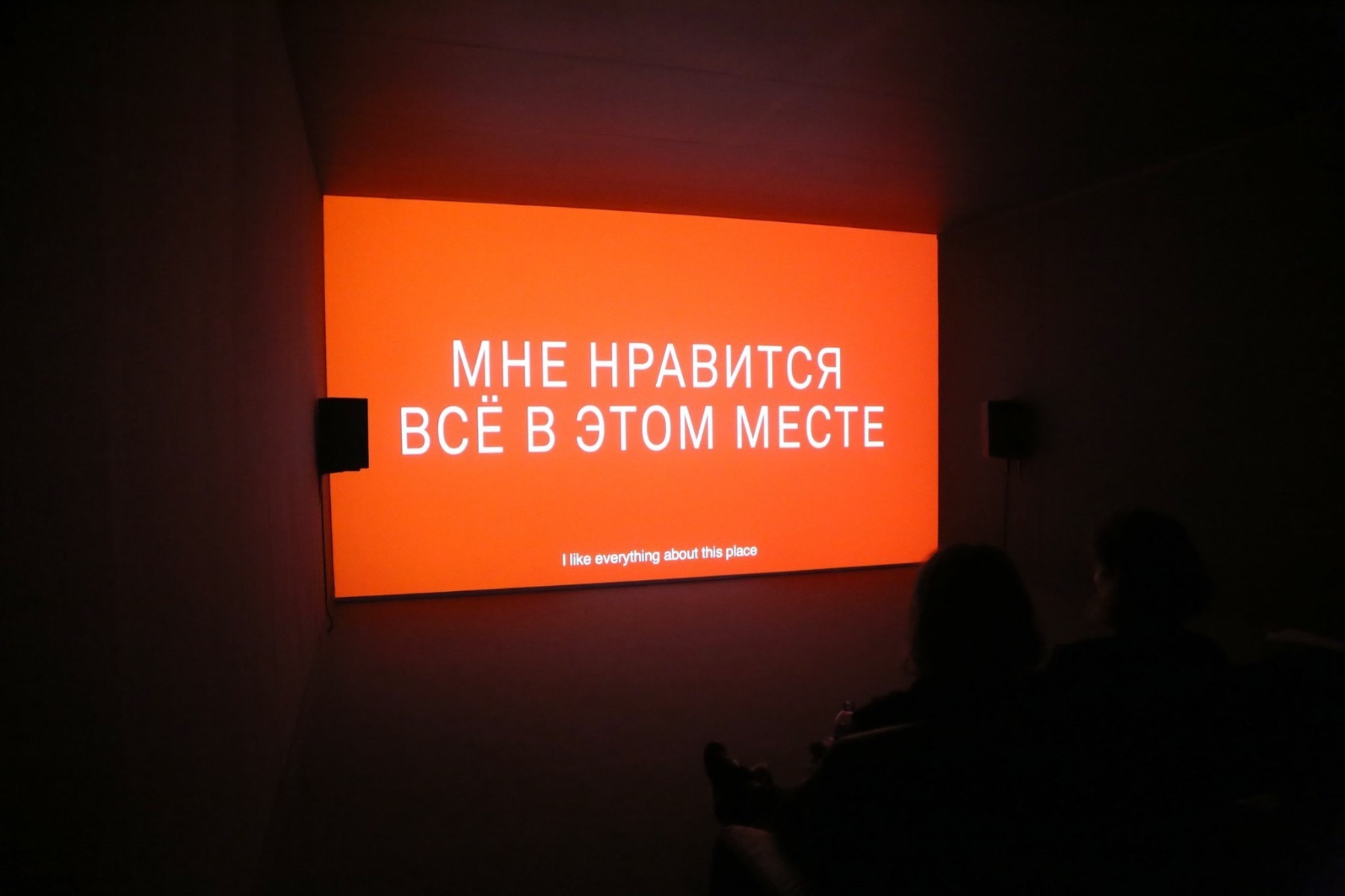
And lately you’ve happened to take an interest in an equally utopian project ‒ cosmism.
It was only quite recently that I realized that Josiah Warren developed his theories simultaneously with the founder of Russian cosmism, [Nikolai] Fedorov. And there’s another connection: [Alexander] Bogdanov started the Institute for Blood Transfusions and developed his ideas for a nationwide network of blood banks throughout the USSR, where an exchange of blood between citizens could take place. Bogdanov was particularly interested in blood transfusions between the elderly and young people. He believed that the blood of the young could rejuvenate the old. At the same time, he thought that the blood of older people probably contains antibodies for all sorts of illnesses (because most of them have already survived illnesses, epidemics, etc.), which can help younger people without such antibodies.
Ironically and sadly, this was the cause of Bogdanov’s own death. He was convinced that he was immune to malaria, and when one of his young students fell ill, he performed a direct blood transfusion to give her his antibodies. He died three days later of blood poisoning. However, from a scientific point of view his theory was correct: certain people do have immunity to various illnesses, and such immunity can be passed on through a transfusion of plasma. Actually this is being done right now with the plasma of people who recovered from Covid-19, as an experimental treatment in the US. Bogdanov’s intuition was essentially correct, he just lacked the necessary knowledge and biotechnology in the 1920s.
In any case, recently it occurred to me that a blood bank is basically also a kind of time bank. This is because its main function is to prolong life: to cure illness, to prevent death and in this way to give people more time.
Personally, I associate cosmism, first of all, with the ideas of Fedorov. It’s this sense of a planetary unity with all the previous generations…
I guess if you see cosmism as a philosophy or an ideology, the insistence on including the rights of the people who are dead is kind of unusual. Normally the dead have few rights and the past is erased rather quickly. Walter Benjamin famously writes about the Angel of History, who looks back and sees nothing but wreckage, death and so on.. When Fedorov looks back, he sees a field of infinite potential: for him the dead are not really dead until all scientific and technological means have been used to revive them. In this sense, the past is never finished because everyone in it has to be resurrected. The optimism implied in this view is very unique.
Is it a potential, or is it instead a certain universal process, of which we are the result?
What I mean by potential is simply that in a condition of immortality, failure as a concept does not make sense, because there is no end and everything can be restarted, tried again, continued ad infinitum. For example, in such a condition we couldn’t say that modernism or socialism failed: anything can be realized, because there is an eternity to make it work.
Anton Vidokle, still from Immortality For All: a film trilogy on Russian Cosmism (2014-2017). HD video, color, sound. 96 minutes. Russian with English subtitles. Courtesy of the artist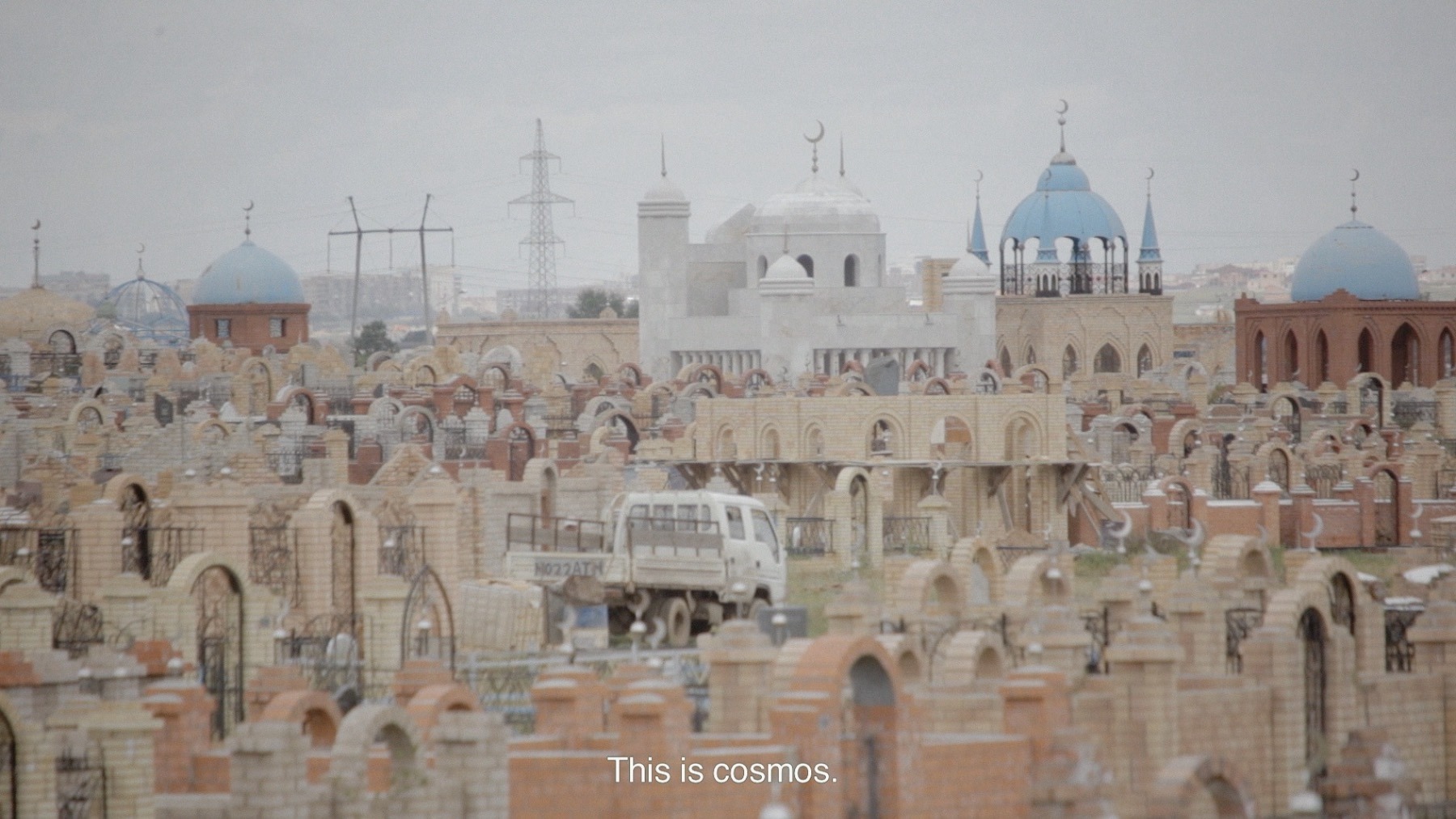
At which point did you decide to make films on this subject?
I came across cosmism relatively recently, about six or seven years ago. Actually Boris Groys did mention some of these ideas to me a long time ago, but they were so strange that I didn’t take them very seriously at that time. They seemed like a macabre science fiction or a bizarre anecdote: immortality through blood transfusion, technological resurrection, etc. For example Boris mentioned that Malevich’s sculptures, the Architektons, were actually intended as designs for orbital stations which would be used as cemeteries where corpses would be preserved outside of Earth’s gravity, in the coldness of outer space, for future resurrection. All this was super fascinating, but did not sound like something grounded in actual history or facts. To be totally honest, I thought Boris made this up… A few years later, I was asked to interview Ilya Kabakov, and at some point he started talking about cosmism in relation to his work. And that’s when I realized that this has a history.
So I looked it up and came across Fedorov’s Common Task. I found the book very moving ‒ initially, not even the actual ideas but Fedorov’s language, because his style of writing is rather unusual for a philosopher. He writes in images: there are three or four images in every sentence. I had never read philosophy written like that, and as an artist I really responded to this type of language. At first, people generally tend to find cosmism a bit simplistic and not very serious, because it’s about literal immortality, literal resurrection, life in the cosmos, which sounds more like a fantasy than something analytical. Basically that’s the program of cosmism in a nutshell and the simplicity of this proposal is deceptive.
Life in the cosmos?
Yes, because there will be too many of us on Earth. So we’ll need to learn to live on other planets, in spaceships, on space stations and so on. But if you start thinking through all of the the social, political, economic and ideological changes that will be necessary to somehow approach this project in practice, it becomes super interesting and very complex. From an economic and/or political point of view, this project is very close to communism: no private property, total equality of all including the dead and the living, no luxuries, no frivolous consumption – everything is common and dedicated to a single goal of achieving immortality for all. In a way it’s even more radical than communism. Because in communism there’s one (or maybe more than one) logical problem: in order to achieve communism, people must sacrifice a lot ‒ practically everything, including their lives. At that, communism doesn’t really offer any compensation for those sacrifices. In cosmism, everybody will be resurrected.
Anton Vidokle, still from Citizens of the Cosmos (2020). HD video, color, sound. 30:19 minutes. Japanese with English subtitles. Courtesy of the artist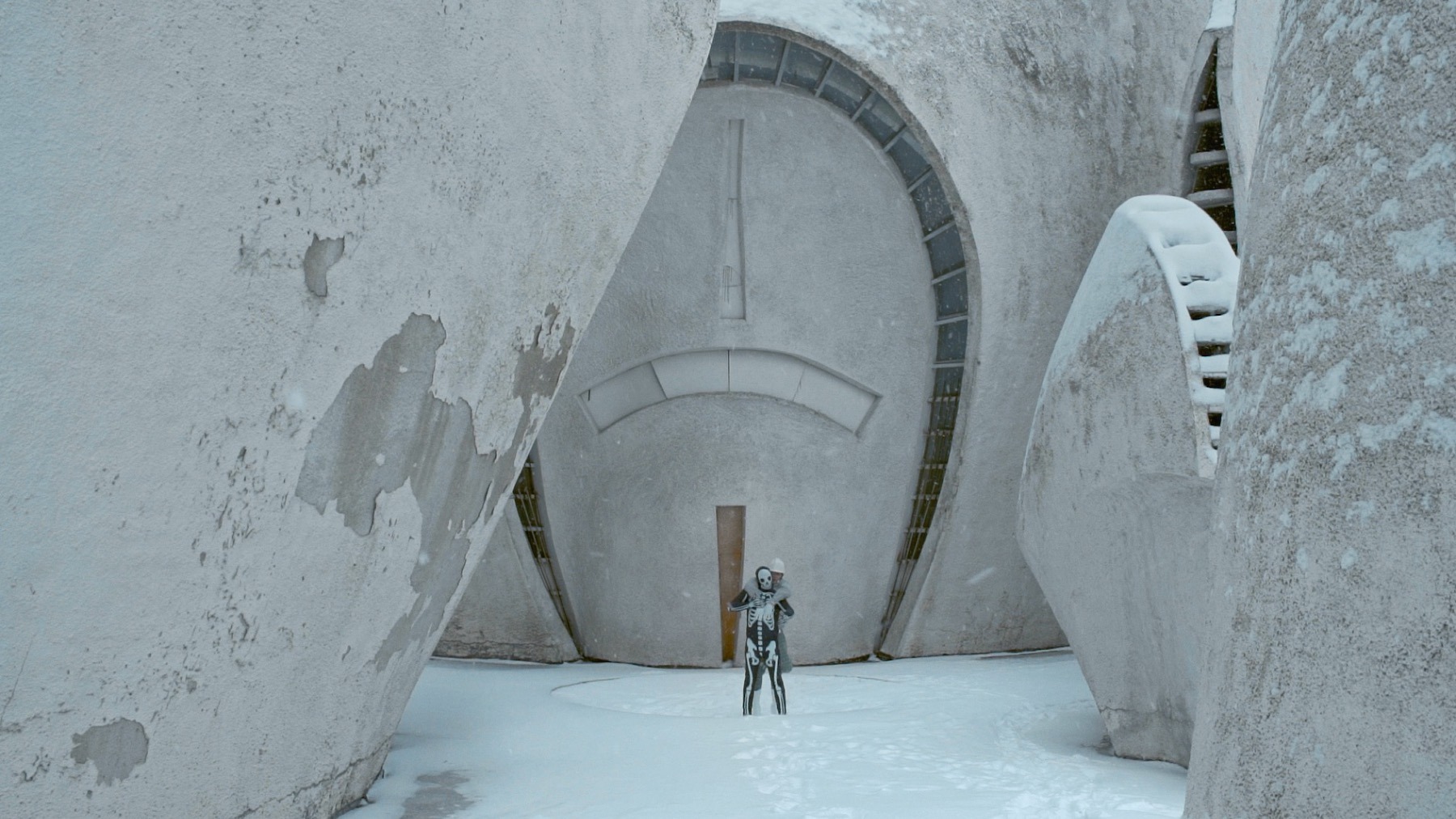
So they actually work for their own benefit?
Yes, they work for the good of all, including themselves.
Initially, I thought that I should organize an exhibition or publish a book about cosmism, because not many people know much about this in the West. But at a certain point I felt that the way Fedorov writes is already a kind of an art. Actually, for him, the “common task” is a collective art project because immortality and resurrection are true works of art. Perhaps it’s not an accident that almost all thinkers, scientists, and others involved in developing cosmist ideas were also very much involved in the arts. Bogdanov wrote science fiction novels and also started Proletkult, the scientist Chizhevsky painted and wrote poetry ‒ practically all of them had an art practice, be it poetry, literature, visual art, etc. So I felt that I needed to find to find a more artistic way of working with this history and these ideas. It felt wrong to work with this subject in a documentary, academic way, that it required something closer to the actual ethos of cosmism, which is closely connected to art.
At the time, the Garage Museum of Contemporary Art in Moscow launched a new program, which they called “Field Research.” They invited me to take part in it. This enabled me to travel through the former territory of the USSR with a camera crew and to see and record what aspects of cosmism could have survived. It was actually quite difficult to make these films, because there are no surviving cosmists anymore that one can interview for example. Also cosmism is something that exists in an ephemeral way: as ideas, texts, poems, novels, a particular worldview, a sensibility -- you can’t really represent it directly. What appealed to me the most was this impossible desire in cosmism to create an all-embracing harmony on Earth and in the universe, while knowing that one does not have the actual, physical means to do this, but attempting anyway because it is what’s needed. Again, this is something very close to art as I understand it and this is something I wanted to try to convey or reflect in the films.
The first film was basically an introduction to cosmism: a collage of key cosmist concepts, in which I attempted to put together passages from writings of its many authors. I was initially hoping to make a feature-length film, but then I realized that because I had no experience in film making, a feature film would be a tall order. So I decided to make several short films, each film dealing with a particular aspect of cosmism.
The second film is partly about the Chizhevsky Chandelier, which for me is a genuine mystical object of the Soviet era. Chizhevsky invented it around 1920s and it was rumored to have a rejuvenating effect. In the 1970s these devices were installed in many key government offices because the people in power at the time were all senior citizens, most of them senile septuagenarians, and somehow they had to restore their tonus. Apparently there were even tiny Chizhevsky Chandeliers in their cars, in these black Soviet limousines.
Anton Vidokle, still from Immortality For All: a film trilogy on Russian Cosmism (2014-2017). HD video, color, sound. 96 minutes. Russian with English subtitles. Courtesy of the artist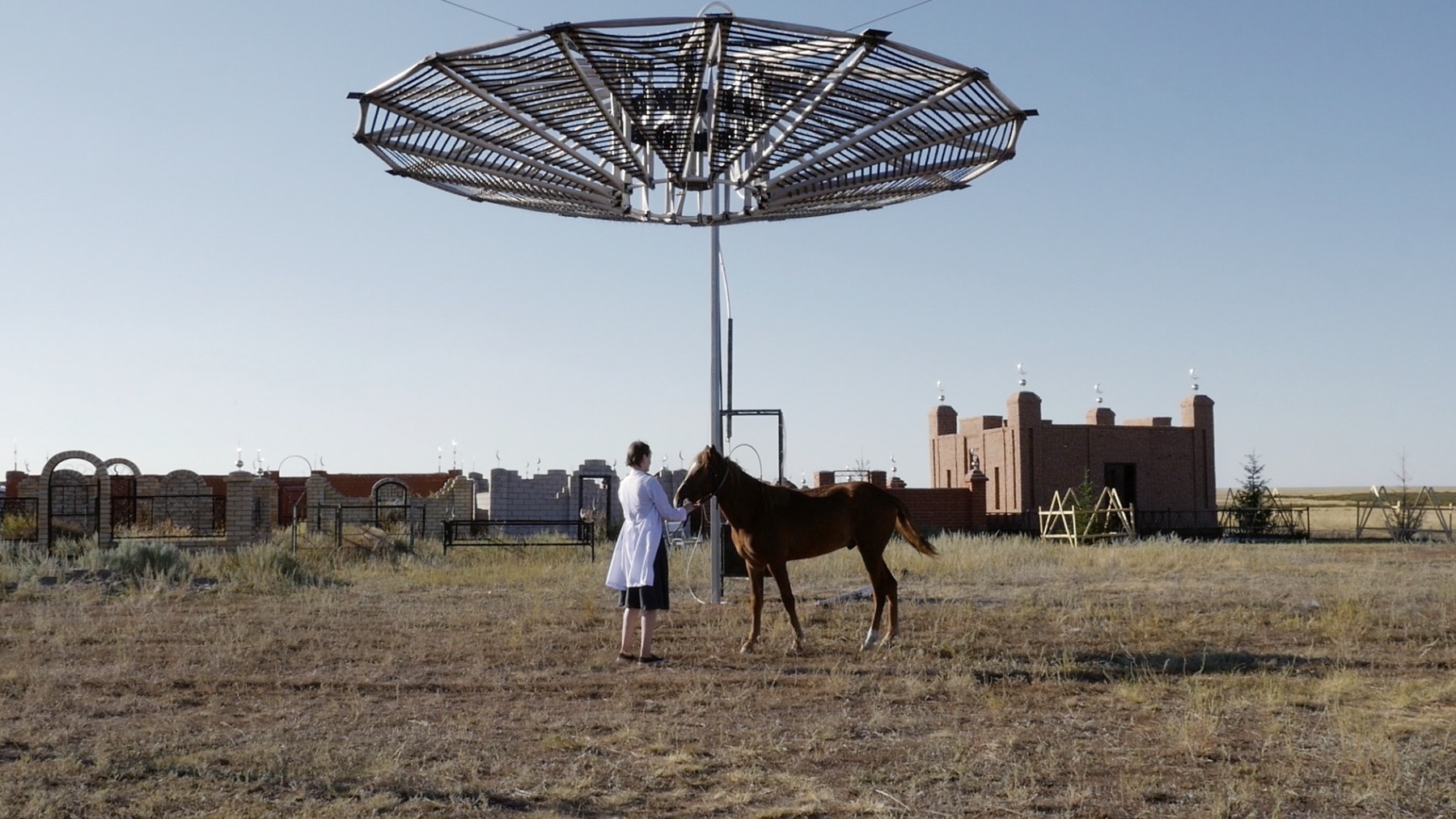
So it’s not a myth ‒ it’s reality?
Yes, it is reality. This device is basically an ioniser, but perhaps not just that. The standard size is approximately one meter in diameter. They create an electric field that breaks up the air molecules and changes the valence of air from positive to negative. This has a therapeutic, rejuvenating effect similar to what we experience when we spend time at the beach, in a forest after a rain or on top of mountains. Air has a lot of negatively charged ions at these types of places. It’s not an accident that this is where most people go to rest and revive on vacation. Chizhevsky’s device produced this effect indoors, in human dwellings.
For this film we had a very large device like this constructed at an experimental workshop in Karaganda that actually specializes in these devices for industrial use. We installed it in a cemetery of a small village at the outskirts of Karaganda in Kazakhstan, where Chizhevsky was in prison and exile for a long time. We were afraid to turn it on: it was so large that people who built it could not predict its effect on our cameras, computers etc. This was also near an airport and we were a little worried about interfering with plane navigation systems or the control tower. But nothing dramatic happened.
This film also introduces Chizhevsky’s theory of the effect of the sun on historical processes. He became interested in this subject when he was a teenager. Chizhevsky, like Tsiolkovsky, grew up in Kaluga, where they met. Tsiolkovsky was very impressed with Chizhevsky, who was a child then, and even gave him a telescope as a gift. Chizhevsky used the telescope to observe the Sun. At the same time, he also followed the military developments, because his father was a military man, an officer in the Tsarist army during the First World War. Over the course of these observations, Chizhevsky noticed that heightened solar activity: sunspots, coronal eruptions, etc., seemed to coincide with intensified military activity at the war front. And he had this intuitive feeling that there had to be a connection there. Later, at the university, his main work became a statistical analysis of solar activity over the past 500 years and the concurrent political and economic events on Earth in human society. He claimed to have found a mathematical correlation between the sun and various cycles in our social life on Earth. The film is called The Communist Revolution Was Caused By The Sun.
As for the third film, it was shot at four museums in Moscow: the Zoological Museum, the Lenin Library, the New Tretyakov Gallery and the Museum of the Revolution, which was renamed the Museum of the History of Russia. Fedorov wrote a very important essay entitled “The Museum, its Meaning and Mission” in which he proposed the idea that the museum would become the site of resurrection. Because a museum is already equipped with technologies for preservation and restoration, and if the existing museological technologies could be developed further and radicalized, the next step should be immortality and resurrection, or “returning life.” And so the third film is about Fedorov’s ideas about museums as sites of resurrection.
Since then, I made several more films, but these are not in Russian. I think the name “Russian cosmism” is slightly unfortunate: Cosmism is by definition a universal philosophy: it’s about immortality for all, resurrection for all, life in the universe, not only in Russia. So I find it interesting to develop these ideas in other languages, in other countries, geographies and cultures in order to explore the universal nature of cosmism. This is one of the reasons why I recently made a film in Tokyo, in Japanese. It’s based on the Biocosmist Manifesto by Alexander Svyatogor written in 1922, which translates to Japanese surprisingly well.
Another recent film is made in New York – also involving museums to some extent, and also dealing with resurrection, but it’s made completely differently, like a fiction film, with actors. Usually I don’t work with professional actors; I prefer to work with ordinary people or amateur actors. Here, however, I worked with two young directors, and we even had an ensemble of professional actors, costumes and all. The idea is relatively simple: in a distant future, a group of people are resurrected by artificial intelligence in something that looks like a museum, but is probably a space station. The artificial intelligence needs them to be living-human displays in a strange museum it created. They may be immortal, but they cannot leave the museum (laughs).
Is it a sort of anti-utopia?
am not a propagandist of cosmism. There is a lot of the absurd and whimsical in cosmism and that’s ok. The film is actually quite funny. It was supposed to be presented in Riga at the Biennial. Of course now it’s not really clear if this exhibition will ever happen, or in which form. It is also possible that this year the only possibility to do an exhibition will be to do it online. So we are back to e-flux…
Anton Vidokle, still from Immortality For All: a film trilogy on Russian Cosmism (2014-2017). HD video, color, sound. 96 minutes. Russian with English subtitles. Courtesy of the artist
In your opinion, is this not perhaps a very anthropocentric idea ‒ to resurrect just people? What about animals?
I read that some of the cosmists actually intended to resurrect animals as well, and not just animals, but also plants and even bacteria. Basically everything that was alive once, every living organism, has a right to immortality within a cosmist worldview.
If this project was not megalomaniac enough, there’s also a kind of a second stage, or a more distant horizon to cosmism, which is even greater. Fedorov mentions this in passing in his writings: once we’re all immortal and resurrected – people, animals and microorganisms alike ‒ what are we going to do with our immortality? His idea was that consciousness is a very special capacity of living matter that needs to be shared with dead matter.. In his thinking it’s our duty, as thinking beings, to share this ability and to teach the inorganic part of the universe to feel and think so that the universe could become one interconnected, conscious organism. This is a bit like animism on a cosmic scale. Once the universe becomes this unified, conscious being, it will be identical to God. It will not replace God, but it will become the same as God.
So basically cosmism is a project of God-building. Again Fedorov describes this specifically as an art project, a work of art.
Yes, teaching this glass to think (I pick up a glass) is not a simple task.
Seems impossible... But you know, there is a lot being published these days about chemical computing. This is a theory that any substance made up of molecules and atoms, can be used to perform calculations chemically. I imagine this (in my rather simplistic, unscientific way) a little bit like the internet of things: if there is a way for all the dead, inert matter to perform calculations, and if artificial intelligence could eventually develop to become a form of true thinking and intelligence, then perhaps there could be a way for the universe to become a kind of a thinking being, or at the very least a very, very large computer.
The strange thing is that in a way we (as in the humans of planet Earth) are already working on this.
Anton Vidokle in Riga at the exhibition “Unexpected Encounters”. Photo: Margarita Ogoļceva, The Latvian Centre for Contemporary Art, 2019